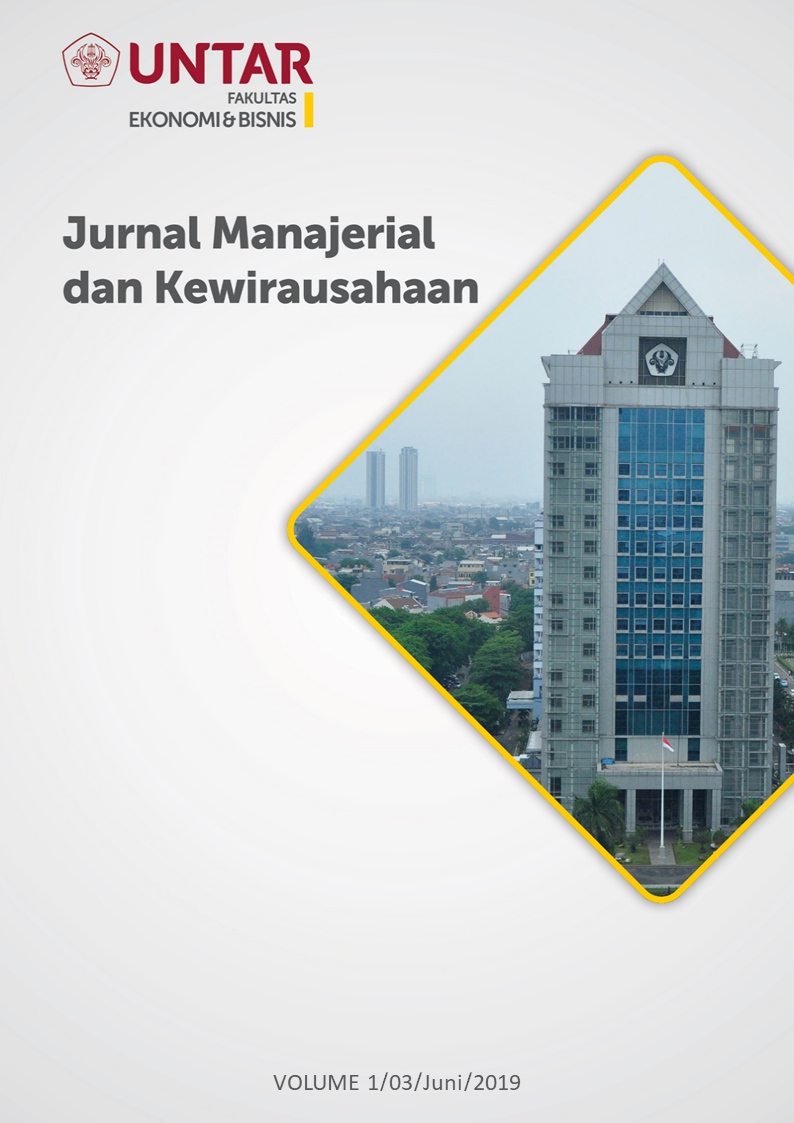Sales Promotion, Store Environment Dan Perceived Value Sebagai Prediktor Terhadap Purchase Decision
Main Article Content
Abstract
This research was aimed to examine empirically sales promotion, store environment and perceived value as predictors of purchase decision of Hero Mall Ciputra consumers at the Faculty of Economics, Tarumanagara University. The sample of this study was the Tarumanagara University Faculty of Economics student. Tools for collection data using questionnaire. The number of respondents sample taken for research is 110 people. Data analysis method used is Multiple Linear Regression Analysis with a significance level of 0.05 and the t-test. The results of this reseacrh showed that sales promotion, store environment and perceived value have a significant effect to purchase decision.
Penelitian ini bertujuan untuk menguji secara empiris sales promotion, store environment dan perceived value sebagai prediktor terhadap purchase decision konsumen Hero Mall Ciputra di Fakultas Ekonomi Universitas Tarumanagara. Sampel penelitian ini adalah mahasiswa/i Fakultas Ekonomi Universitas Tarumanagara. Alat untuk mengumpulkan data menggunakan kuesioner. Jumlah sampel di dalam penelitian ini sebanyak 110 orang. Metode analisis data yang digunakan adalah Analisis Regresi Linear Ganda dengan tingkat signifikansi sebesar 0,05, dan uji-t. Hasil penelitian ini menunjukkan bahwa sales promotion, store environment dan perceived value berpengaruh signifikan terhadap purchase decision.
Article Details
This work is licensed under a Jurnal Muara Ilmu Ekonomi dan Bisnis Creative Commons Attribution-ShareAlike 4.0 International License.,/p>
References
Ajzen, I. (1991). The theory of planned behaviour. Organizational behaviour and human
decision processes, 50(2), 179-211.
Amirullah. (2002). Perilaku Konsumen. Yogyakarta: Graha Ilmu
Chen, Z., and Dubinsky, A. J. (2003). A conceptual model of perceived customer value in ecommerce: a preliminary investigation. Psychology and Marketing, 20(4), 323-347.
doi: 10.1002/mar.10076
Chih-Yi, Wu and Chien-Ping, Chung (2016). The Effects of Store Atmosphere and Sales
Promotion on Purchase Intention ? Perceived Customer Mood as a Mediator. Business
Research Review, 2(1), 33-50.
Hanaysha, R. J. (2017). Customer Retention and the Mediating Role of Perceived Value in
Retail Industry. World Journal of Entrepreneurship, Management and Sustainable
Development, 14(1), 2-24. doi:10.1108/WJEMSD-06-2017-0035
______________ (2018). An examination of the factors affecting consumer’s purchase
decision in the Malaysian Retail Market. PSU Reseacrh Review, 2(1), 7-23.
doi:10.1108/PRR-08-2017-0034
Hasan, Iqbal. (2002). Metode Penelitian dan Aplikasinya. Bogor: Ghalia Indonesia.
Kotler, P., and Keller, K. (2012). Marketing Management (14th ed). The United States of
America: Pearson Education, Inc.
_________ and Armstrong, G. (2012). Principles of Marketing (14th ed). Upper Saddle River,
New Jersey: Pearson Education, Inc.
Maholtra, N. K. (2010). Marketing Reserach (Global Ed). New Jersey 07548: Pearson
Education, Inc.
Mohan, G., Sivakumaran, B., and Sharma, P. (2012). Impact of Store Environment on Impulse
Buying Behavior. European Journal of Marketing, 47(10), 1711-1732.
doi:10.1108/ejm-03-2011-0110
Sekaran, U., and Bougie, R. (2010). Research Methods for Business (6th ed). Italy: Printer
Trento Srl.
Solomon, M. R., Marshall, G. W., and Stuart, E. W.
(2012). Marketing: Real People Real
Choices (7th ed). Upper Saddle River, New Jersey: Pearson Education, Inc.
Sudaryono. (2018). Metodologi Penelitian. Depok: Rajawali Pers
Zeithaml, V. A. (1988). Consumer perceptions of price, quality, and value: a means-end model
and synthesis of evidence. Journal of Marketing, 52(3). 2-22.



